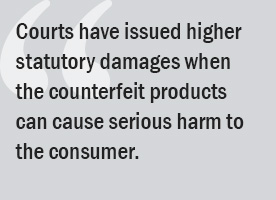Anticounterfeiting Committee Reports on Statutory Damages Trends in the United States
Published: October 1, 2019
Justin R. Gaudio Greer, Burns & Crain, Ltd Chicago, Illinois, USA
 INTA’s Anticounterfeiting Committee, United States Subcommittee, has compiled a new report analyzing trademark statutory damages trends in the United States, surveying 77 cases nationwide.
INTA’s Anticounterfeiting Committee, United States Subcommittee, has compiled a new report analyzing trademark statutory damages trends in the United States, surveying 77 cases nationwide.
Background:
In the United States, an action for trademark infringement may be brought under the Lanham Act. In counterfeiting cases, the plaintiff may elect to recover statutory damages rather than actual damages under 15 U.S.C. Section 1117(c). In 2009, Section 1117(c) was updated, doubling the amount allowed for statutory damages in non-willful and willful counterfeiting cases.
In non-willful cases, damages were increased to the amounts of $1,000 to $200,000, and up to $2 million in willful counterfeiting cases. Although Section 1117(c) details the statutory damages awards, it does not provide guidance on the factors a court should consider when determining an award within those boundaries.
Reported Findings
The report revealed the following 10 primary factors that courts took into account in formulating statutory damages awards:
- The plaintiff’s level of difficulty in proving actual damages;
- Circumstances of the counterfeit activity;
- Deterrence to the defendant and other similarly situated sellers;
- The defendant’s profits and saving gained by the sale of illegitimate products;
- The plaintiff’s loss of revenue due to the defendant’s counterfeiting activities;
- Value of the plaintiff’s trademark;
- Willfulness of the defendant’s conduct;
- The defendant’s cooperation in court proceedings, including appearance or non-appearance in court;
- Whether the counterfeiting activity took place online or offline; and
- Repeated trademark violations by the defendant.
Although most cases did not approach the maximum damages allowed by law, analysis showed that the average award after the 2009 update was approximately $320,000 per mark/good, compared to approximately $130,000 per mark/good before 2009.
Additional findings of the report include the following:
- Jury awards were substantially higher than awards from judges, ranging from $500,000 to more than $10,500,000, with a median award of $3,520,000.
- Median awards for claims against online stores were higher than brick and mortar.
- The Second, Seventh, and Ninth Circuit Courts have considerable more experience with counterfeiting cases (a total of 46 out of 77 cases surveyed were heard in the three circuits) and award higher damages than the other circuits.
- Courts have issued higher statutory damages in cases where the counterfeit products could cause serious harm to the consumer.
To view the complete report, please visit INTA’s website here.
Although every effort has been made to verify the accuracy of items in the INTA Bulletin, readers are urged to check independently on matters of specific concern or interest.
© 2019 International Trademark Association
This website uses cookies so that we can provide you with the best user experience possible. Cookie information is stored in your browser and performs functions such as recognising you when you return to our website and helping our team to understand which sections of the website you find most interesting and useful.
To find out more please see our Cookies Policy and Privacy Policy.
These cookies are used to identify a user’s browser as the visitor goes from page to page on the Site. These are session cookies, which means that the cookie is deleted when you leave the Site. It is an integral piece of the Site software and used to let the server know which users are on the Site at any given time and make certain parts of the Site easier to use.
|
|
If you disable this cookie, we will not be able to save your preferences. This means that every time you visit this website you will need to enable or disable cookies again.
These cookies are used to collect information about how visitors use our Site. The cookies collect information in anonymous form, including the numbers of visitors to the Site, where visitors have come to the Site from, the pages they visited and how they have interacted with tools on the Site like search and embedded media players. We use the information to compile statistical reports of our users’ browsing patterns so that we can improve the Site.
|
|
Please enable Functionality Cookies first so that we can save your preferences!
These cookies are used to deliver advertising relevant to the interests of visitors to our Site. They are persistent, which means they will remain on your device after you leave the Site.
- Facebook (Ad Pixel)
- Google (Ad Pixel)
- LinkedIn (Ad Pixel)
- Quattro Anonymous
Please enable Functionality Cookies first so that we can save your preferences!
